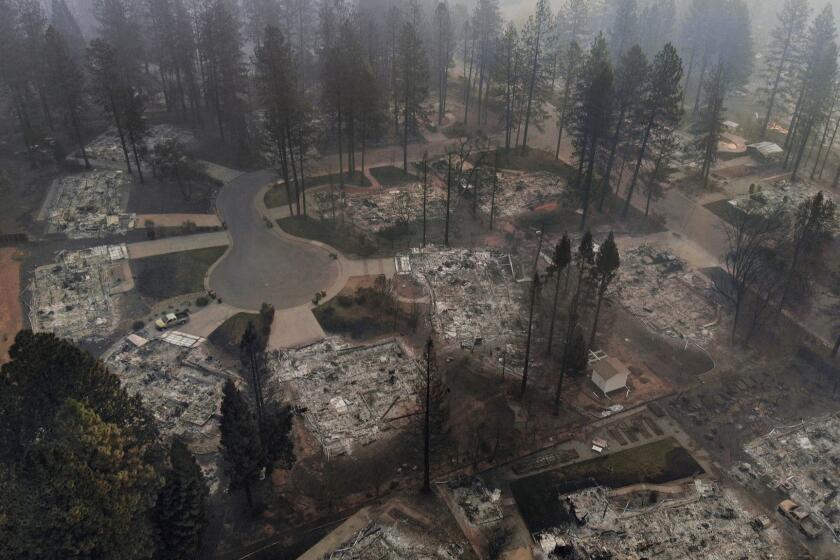Southern California Edison preserving equipment near Eaton fire starting point

- Share via
The number of faults on the power grid near three of the major Los Angeles County fires skyrocketed in the hours before the blazes began, according to a company that monitors electrical activity.
Bob Marshall, the chief executive of Whisker Labs, said in an interview with The Times that the areas near the Eaton, Palisades and Hurst fires all saw massive increases in faults in the hours leading up to the fires. Faults on the power grid are caused by tree limbs hitting electrical wires or wires hitting one another, among other causes. Each fault causes a spark.
The fires together have destroyed or damaged more than 9,000 structures. Power equipment has caused destructive wind-driven California wildfires in the past, but L.A. city and county fire officials say their investigators have not determined what sparked any of the fires.
“What I cannot say is one of these faults sparked the fire. I don’t know that,” Marshall said in an interview. “But it just takes one to start the fire.”
Data shared with The Times, but not yet released publicly, showed the increase in faults.
In the area of the Palisades fire, in the hour before the fire started, there were 25 faults on the grid. In the hour that the fire started, there were 18 faults, according to Whisker Labs’ data.
Coverage of the fires ravaging Altadena, Malibu, Pacific Palisades and Pasadena, including stories about the devastation, issues firefighters faced and the weather.
The Eaton fire had even more faults. In that area, there were 50 faults in the hour that the fire started, according to Whisker Labs’ data.
At the Hurst fire, there were 51 faults the hour the fire was reported, according to Whisker Labs’ data. That came after four hours of continuous high fault levels. There were 120 faults in the four previous hours, according to Whisker Labs’ data.
That means that despite the sparks flying in the area, over the previous four hours energy was left on.
“What we know is the lines were not de-energized prior to the ignition of fire,” Marshall said. “The problem is the utilities don’t have the sensors to know this is occurring. This sensor network is sophisticated and sensitive. We have more information than they do. Our objective, we’ve been trying to get utilities to pay attention to the data because it’s valuable to know when the grid is stressed.”
In all three of those areas, faults in the days leading up to the fires were negligible, with only a few occurring.
Investigators with the California Department of Forestry and Fire Protection have concluded that Pacific Gas & Electric equipment sparked the devastating Camp fire that destroyed nearly 14,000 homes and killed 85 people, most of them elderly, last year.
On Thursday, Southern California Edison also notified the California Public Utilities Commission that it had received a number of notices, from attorneys representing insurance companies, to preserve evidence regarding the Eaton fire.
In the notice, the company also acknowledged that there were “online publications that seemingly suggest SCE equipment may be associated with its cause.”
In the report, however, the company said preliminary analysis of electrical circuit information for the transmission lines in the area showed interruptions or anomalies until more than an hour after the Eaton fire started.
“To date, no fire agency has suggested that SCE’s electrical facilities were involved in the ignition,” the report states.
SCE did not immediately respond to a request for comment.
Whisker Labs monitors electrical data using its Ting sensors, which monitor about 14,000 homes in the Los Angeles area. The monitors help Angelenos stop electrical fires in their homes, but taken together provide information on the entire power grid.
“So when something bad happens on grid — a power outage or surge — we see that because it’s measured by many sensors,” Marshall said.
Robert Garcia, the Angeles National Forest fire chief for the U.S. Forest Service, said at a news conference that the cause of the Eaton fire remains under investigation but there are a number of factors to consider.
“There’s a number of different activities in [Eaton Canyon],” Garcia said. There were members of the public “in there when it was occurring. And there’s power lines [that] run through there. So we have teams looking at all [possible starts].”
L.A. fire officials say the cause of the Palisades fire is also still under review.
More to Read
Sign up for Essential California
The most important California stories and recommendations in your inbox every morning.
You may occasionally receive promotional content from the Los Angeles Times.














